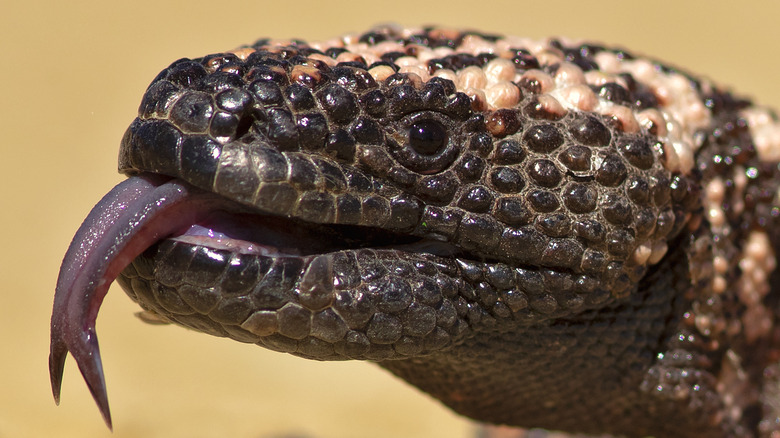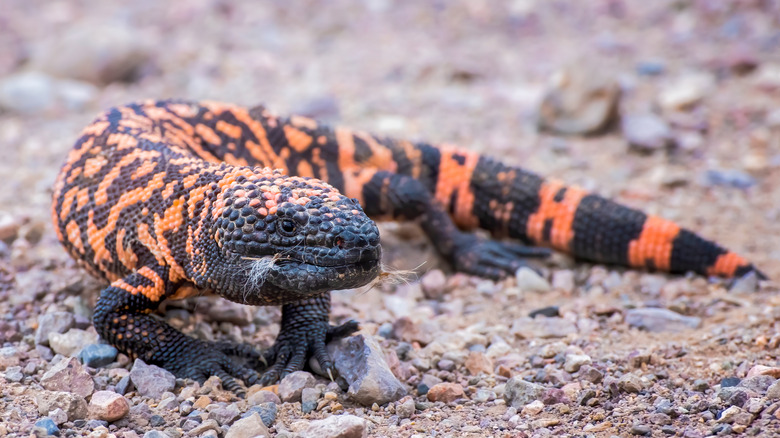Could Gila Monster Venom Hold The Key To Curing Diabetes?
Have you ever seen a Gila monster? It might sound like the stuff of fairy tales, but Gila monsters are actually very real animals whose natural habitats stretch from Mexico up into the United States (via National Geographic). As large lizards with black and orange skin, Gila monsters are hard to miss once you've seen one (via the Smithsonian National Zoo & Conservation Biology Institute).
That's probably a good thing. Gila monsters are venomous animals, possessing a potent toxin that they can inject from their teeth, according to the Smithsonian National Zoo. This venom can pose a threat to people's health if a Gila monster-human interaction goes poorly, especially since there are no antivenoms for the Gila monster bite. However, it's worth noting that when Gila monsters bite humans, the interactions are rarely fatal; the last time someone died directly from a Gila monster bite was in 1939 (via Utah State University Human Wildlife Interactions).
Some evidence suggests that Gila monsters could offer a net benefit to the human species. That's because the lizard's venom may hold the secret to curing diabetes (via Science Daily).
What is diabetes?
Diabetes is a disease related to how the body processes blood sugar, according to the National Institute of Diabetes and Digestive and Kidney Diseases. A hormone called insulin normally regulates blood sugar levels. However, for some people, this process goes awry.
There are a few types of diabetes, including Type 1 and Type 2 diabetes, according to Healthline. Type 1 diabetes is a genetic condition in which the body is largely unable to produce insulin due to autoimmune issues within the insulin-producing organ, the pancreas (via Life Line Screening). On the other hand, Type 2 diabetes is a condition that is developed over time, often due to factors such as diet and exercise levels. Type 2 diabetics do not produce enough insulin to manage their blood sugar levels.
Both types of diabetes can be dangerous. However, they are diagnosed and treated differently. While Type 1 diabetes is usually identified early in life and treated with insulin injections, Type 2 diabetes is usually diagnosed later, and is often treated with lifestyle changes like diet and exercise (via Healthline), as well as medications to reduce blood sugar levels (via the American Diabetes Association).
How Gila monster venom helps diabetics
So how can toxic lizard venom help in the fight against diabetes? While it might seem strange to look at venom for a medical cure, it's actually not that uncommon for scientists to turn to wild plants and animals in the search for new medicines (via the BBC). Many compounds found in nature are relatively unknown to scientists, so they have the potential to be medicinal. And some research has suggested that Gila monster venom contains such compounds (via the U.S. Department of Veterans Affairs).
A hormone identified in Gila monster saliva has been proven to increase the production of insulin in humans. Scientists working at pharmaceutical companies studied the hormone and created a drug based off of it, called Exenatide. That drug was extensively medically tested, according to Science Daily, and shown to help Type 2 diabetics stabilize their blood sugar and even lose weight. The drug is not a cure for diabetes, but it's a step in the right direction. With further research into diabetes, and further investigation of animals like the Gila monster, who knows what else could be uncovered?


